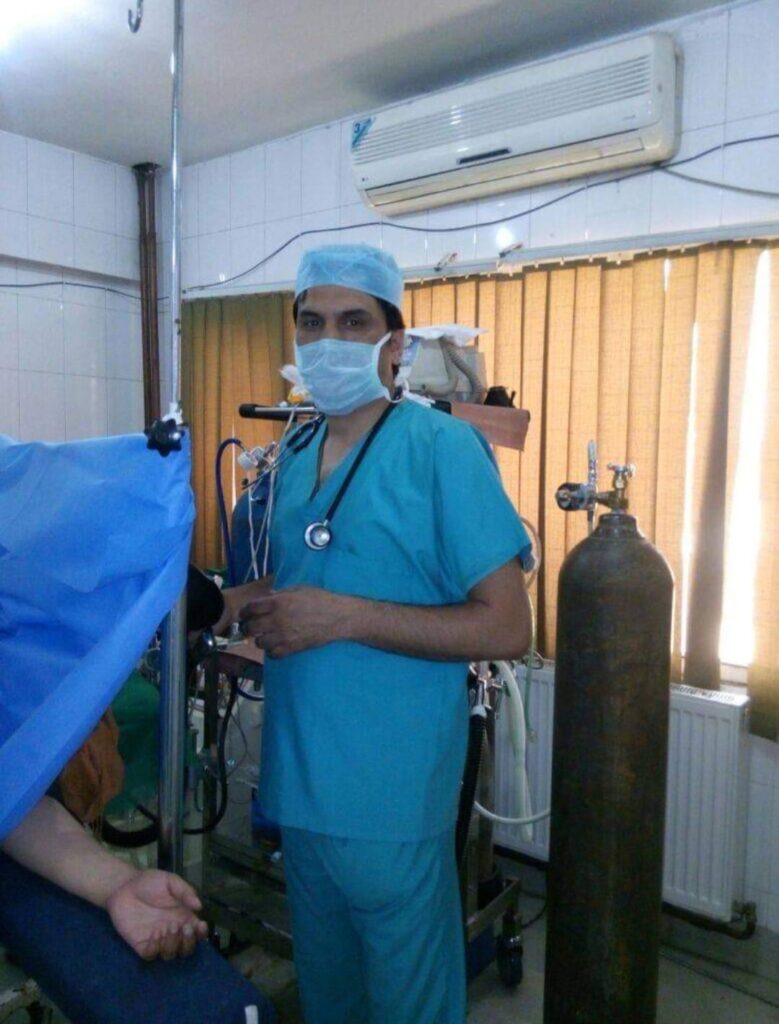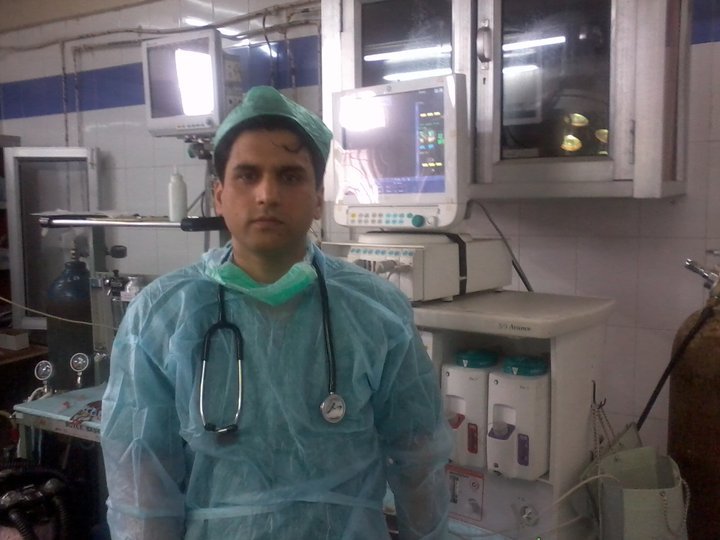Collaboration, Cooperation and effective teamwork is the key to achieving good results in patient management: Dr Masood Rashid
By Ajaz Rashid
Dr. Masood Rashid, a distinguished anaesthetist hailing from Hawal, Downtown Srinagar, has made remarkable contributions to the field of medicine. Born and raised in a middle-class family, Dr. Rashid’s parents instilled in him the values of hard work and perseverance. His father, a successful businessman dealing in pharmaceuticals, and his mother, a homemaker, provided him with a nurturing environment to pursue his dreams. Dr. Rashid’s academic credentials speak for themselves, having completed his MBBS from ASCOMS Jammu and post-graduation in Anaesthesia from Government Medical College (GMC), Srinagar. His dedication to his craft and unwavering commitment to his patients make him a true asset to the medical profession. During an exclusive interview with Era of Kashmir, Dr. Rashid, a highly skilled and experienced medical professional, shared his extensive knowledge and expertise in the field of medicine. Behind the Scenes: Anaesthetist on the Challenges of Administering Anesthesia
Excerpts of the interview
AR). What inspired you to become an anesthesiologist, and how did you get started in this field?
MR) The inspiration to become a doctor came early for me, my uncle Late Prof Dr M S Misgar, a renowned surgeon and former Principal and HOD Surgery at GMC Srinagar, played a pivotal role in my career choice. In 2008, I began my professional journey as an anesthesiologist at GMC Srinagar, where I acquired ample experience in Intensive Care Unit and emergency resuscitation during my tenure in the Medical ICU and Emergency Medicine departments for three years. As I know all too well, anesthesiology is a life-saving branch of medicine and serves as the backbone of critical care and every surgical procedure.

AR) What are some of the most common procedures that you provide anesthesia for, and what are the challenges associated with each of them?
MR) As an anaesthetist, I am responsible for administering anaesthesia to patients undergoing a range of medical procedures, including but not limited to General surgery, laparoscopic surgery, urology, ENT, ophthalmology, gynaecology & obstetric, and pediatric procedures. However, administering anaesthesia carries with it a certain degree of risk, particularly when it comes to patients with underlying medical conditions such as Hypertension, Diabetes, Dyslipidemia, thyroid disorders, COPD, Asthma, and other related conditions commonly seen in our society. Therefore, special precautions must be taken when administering anaesthesia to such patients undergoing surgical procedures to ensure their safety and well-being.
AR). How do you work with other medical professionals, such as surgeons and nurses, to ensure that patients receive the best possible care?
MR) I firmly believes that effective teamwork is the key to achieving good results in patient management. As such, I always strives to maintain positive and cordial relationships with other medical professionals, including surgeons, paramedics, operation theatre and anaesthesia technicians, and post-operative staff. To me, every individual in the team plays an essential role in ensuring the best possible outcomes for patients. I never hesitate to seek the opinions and assistance of other specialists, such as cardiologists, pulmonologists, and internists, whenever the need arises. There is no room for ego in the practice of anesthesiology, which demands cooperation and collaboration among all team members for optimal results.
AR) What are some of the most important considerations when administering anesthesia, such as dosage, patient history, and potential complications?
MR) I do understand that every surgical procedure carries inherent risks in addition to its potential benefits, and the use of anaesthesia is no exception. However, my experience in handling high-risk cases, particularly those involving cardiomyopathies, valvular diseases, or neurological disabilities, which present unique challenges. Prior to any procedure, I take the time to counsel my patients, clearly explaining the risk versus benefit ratio and ensuring that they are fully informed and comfortable with the planned course of action. In this way, I prioritize patient safety and informed decision-making, while also striving to provide the best possible care for each individual case.
AR) How do you stay up-to-date with the latest advances in anesthesia technology and techniques, and how do you incorporate this knowledge into your practice?
MR) As a practicing anaesthesiologist, I believe that staying up-to-date with the latest techniques and management strategies is critical to success in my field. In order to provide the best possible care for my patients, I recognize the importance of remaining current with the most recent developments in medical field. To achieve this goal, I make a conscious effort to regularly engage in ongoing professional development and education. This includes attending conferences, workshops, and other training opportunities as needed. By prioritizing the pursuit of knowledge and skills, I am able to stay at the forefront of my profession and maintain my commitment to providing the highest quality care to my patients.
AR) What are some of the most rewarding aspects of your work as an anesthesiologist, and what are some of the biggest challenges that you face?
MR) As a member of the emergency and anesthesia team at GMC Srinagar, I was involved in establishing the Medical Intensive Care Unit (MICU) and Triage primary resuscitation unit. This was a challenging task, but through our team’s coordination and collaboration, we achieved a huge success. Additionally, I had the opportunity to be a part of a team that managed cases of chronic neurological or other debilitating disease patients on ventilator for months, which required a great deal of patience and courage.
One of the most fulfilling aspects of my work has been successfully managing many life-threatening cases, including anaphylactic shock, angioedema, succinylcholine apnoea, pulmonary thromboembolism, cardiac arrest, status epilepticus, acute severe asthma, and life-threatening arrhythmias, with the help of my team. I attribute our success to the power of teamwork, as we always work together to achieve positive outcomes for our patients. Overall, being a part of a team that saves lives is a truly rewarding experience.

AR) How do you prioritize patient safety and comfort during anesthesia, and what steps do you take to minimize the risk of complications?
MR) As an anesthesiologist, I believe that performing a preanesthesia check-up (PAC) on patients prior to routine cases is essential. In emergency situations, we conduct on-table PAC to ensure patient safety. Taking a thorough medical history is a critical component of the PAC, as it helps to identify potential complications during the perioperative period. We also make sure to explain the risks of the procedure to the patient’s attendants and refer patients to higher centres if necessary. Accurate dosage of anesthesia drugs is crucial for effective management, and we take great care to avoid any callousness in this area. By prioritizing patient safety through preoperative assessment and careful drug administration, we can provide the best possible outcomes for our patients.
AR) What are after effects of anethesia and how to tackle with that?
MR) I have seen that adverse effects or side effects can occur during anesthesia administration. However, I always follow established protocols to minimize any potential complications. Before any surgical procedure, I conduct a thorough pre-anesthesia checkup and use checklists and preoperative monitoring to ensure the safety of the patient. I also believe in avoiding any unnecessary risks or heroics, as patient safety is always my top priority.”
AR) There is a myth among women folk that Spinal anethesia have more complications than General anethesia. What is your take?
MR) I would say that spinal anesthesia is usually a safer and better option for obstetric cases, especially for lower segment cesarean sections (LSCS), compared to general anesthesia. However, it is important to note that there may be contraindications that make general anesthesia necessary. In general, patients should be educated about their options and potential risks and benefits of each method before making a decision. Ultimately, the choice of anesthesia should be made based on the patient’s individual needs and medical history, in consultation with their healthcare provider.
AR) What advice would you give to individuals who are considering a career as an anesthesiologist, and what qualities do you think are necessary to succeed in this field?
MR) The work of Anesthesiologists goes beyond providing anesthesia in the operating room. We are also responsible for intensive care unit (ICU) care, cardiac anesthesia, neuro anesthesia, pain management, and palliative treatment. Emergency patient care is also a crucial part of our job. Although the work output is substantial, recognition in our field is often lacking. Nevertheless, I am proud of the role we play in ensuring patients receive optimal care throughout their medical journey. To all those who aspire to be anesthesiologists, I wish them ‘the best of luck in their career’.


Comments are closed.